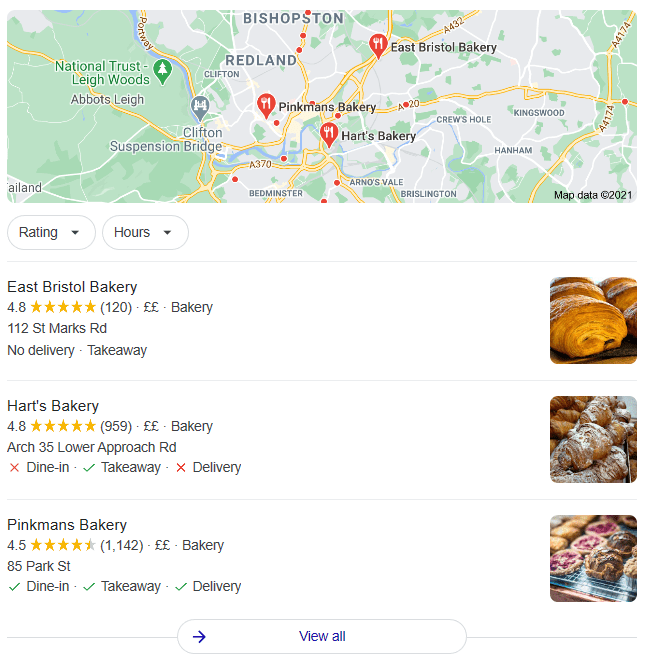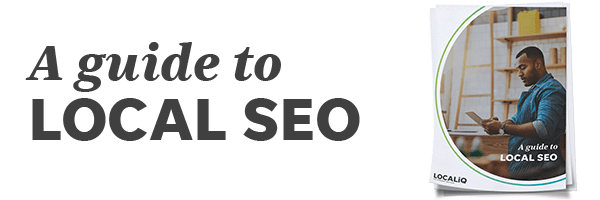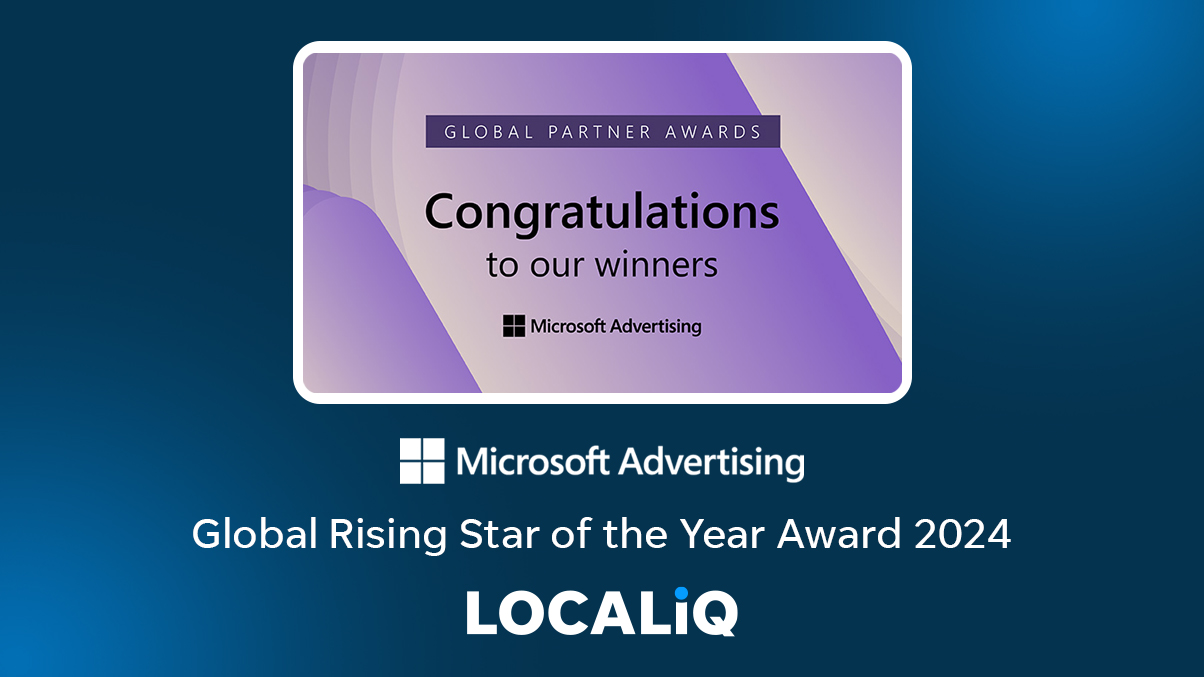Search engine optimisation (SEO) has become essential for local businesses looking to boost their website traffic. Whilst ranking top of Google nationally seems like the logical goal, it isn’t always an achievable goal and might not always be the most important factor of SEO success.
Whilst it’s never been easier to shop for goods online and have them shipped across the country, a lot of users who are searching for businesses are looking for something local to them. It’s unlikely potential customers will be willing to travel across the country just to pick up a takeaway, no matter how good it is. 9 times out of 10 they’ll be looking for something local to them for convenience.
Aiming to rank higher in local searches is a much better place to start. Not only will your website be more relevant to users searching for local businesses, you’ll also have less competition locally than you would nationally.
Prepare for SEO take off 🚀
Take the first step to ranking higher with our free SEO audit.
Get a complete overview of optimisation opportunities and uncover the actions you need to take to scale the SERPs.
What is local SEO?
Local SEO is a great way to promote your online content to local users. The aim is to get your pages and services ranking higher in search results for location-specific keywords, such as Manchester or Cardiff.
How is this done? Well, much like regular SEO, search engines collate information from “signals” such as content, social profile pages and links to provide local and relevant results to the user.
There are distinct differences between the two though. With regular SEO you’d be looking to appeal to a broader, national/international audience, regardless of their location, but with local SEO the aim is to attract users in your area right now.
Is Local SEO a new practice?
Whilst not necessarily a new practice, Local SEO is something that has evolved as a focus for search engines. There was a time when searching “restaurants near me” wouldn’t have yielded such accurate results.
Google first acknowledged a need for a more geographically refined approach in 2004 when it launched its ‘Google local’ service. This feature provided access to information on local businesses in a similar way to a listings directory, all housed natively on the Google platform. Google’s local offering has changed names and taken many forms over the years. We’ve seen the introduction of Google Maps and with it the ability to get directions to local businesses straight from your smartphone.
These days the search giant provides a tool called Google My Business which allows local business owners to edit and control their business information online.
Google aren’t the only search engine focusing on local search though, Bing launched Bing Places for Business in 2013 and Yahoo also have their “Yahoo! Small Business” service.
Why is local SEO important?
Getting Local SEO right is hugely important if you want to grow your business. 48% of all searches on Google are for local businesses, meaning if you’re not ranking, you’re missing out.
SEO gives you the ability to be one of the first businesses a potential customer sees when they’re searching for businesses like yours. A lot of businesses depend on their immediate communities for custom. Businesses like hairdressers, beauty salons, bars and restaurants all rely on local footfall, so it makes sense for these businesses to direct their marketing efforts into targeting an audience in their immediate area. This is why local SEO is vital.
Local SEO indicates to google that your business is able to provide a service that a local user is searching for. When Google recognises your relevance, it starts to push your website up the search results page, which in turn, increases your visibility.
Search engine’s look at a few things when deciding how to rank your website. Your site structure, backlinks and keywords all play a massive part in getting your website ranked.
Local SEO ranking factors
When search engines rank you locally, they rely on a variety of ‘signals’ to ensure your website/content is relevant to the user. Google’s algorithm splits these signals into three categories to produce local search results. These categories are relevance, distance and prominence.
Relevance
To rank well for local SEO you’ll want to prove to search engines that your website is relevant to a user’s query. Search engines will look at your listings information, keywords and on-page SEO to determine if your website is relevant.
Listing Information
Search engines will examine in the information from any online listing directories you may be appearing on. In fact, Google uses its own Google My Business service as its top local ranking factor. If you’re not already using these online directories, they often play a big part in improving your local SEO efforts, as well as improving your online reach in general.
It is paramount that your business’s NAP (name, address, phone number) is correctly cited across all of these accounts. You should also take some time to ensure that you have no duplicate listings. Duplicate listings get created when there are different variations of the business name, address or phone number across online directories and even something as minor as varying punctuation can negatively affect your local SEO results.
Aside from the above, you should ensure the two features below are completed on your listing:
Add a business description
Don’t give in to the temptation of leaving your business description blank, it’s a great way to let users and search engines know if your business matches a need. You should keep this information concise and impartial, free from any marketing offers or attempts at sales pitches.
Local Category Selection
To help define relevance and rank well locally you should select relevant categories for your listing. Think of these categories as tags that will define your business.
Keywords
Keywords are a way of defining what your business is all about. They should be words or queries that users will be searching for.
It seems obvious, but to rank well locally you’ll want to ensure that you’re targeting keywords that are both relevant to your business-type and location. Optimising your web pages using these keywords will naturally increase relevance and hopefully provide an increased chance of being favoured by the search algorithm. Google will also look at your website content and structure, so it is important you understand and implement on-page SEO.
Distance
Proximity to the searcher is considered the top-ranking factor in local SEO. How do search engines determine a user’s location? Well, if you’re using a desktop PC or laptop then typically it will use a list of WiFi access points you’re able to connect to as an indicator of location. And if you’re using a mobile phone or tablet, search engines will rely on the GPS location of that device.
There are two ways a user might conduct a location-based search:
Non-geo modified Search
This is when no location is specified in the search query. For instance, the user may search for “Chinese restaurant”. If this is the case, Google will try to display the most locally relevant results based on what information they have on the users’ location.
Geo Modified Search
This is when a location is specified in the search query. Maybe the user will be visiting a neighbouring city and wants to book a restaurant in advance. In this instance They’d probably conduct a search like: “Chinese Restaurants in location X”. Google would then show the most locally relevant results for the location specified in the search term. Users tend to search like this if they are planning a daytrip or holiday.
Prominence
Prominence indicates how well-known or prestigious a business is. There are places in the offline world that are deemed more note-worthy, like famous museums, hotels and well-known shop brands. These are likely to be prominent in local search results.
Search engines will also look at what makes your business unique compared to other local businesses competing for the same search queries. To rank well for prominence, you want to be building your online presence across the web. Reviews, links and citations are all things that can influence search engines to see your brand as a credible source.
Reviews
Reviews are a free and powerful way of building a reputation online and can help inform potential customers considering purchases, whilst telling search engines that your business is trustworthy.
If you do put efforts into building up reviews, you should be looking to reply to each review you get, good or bad. This shows potential customers that you care and shows search engines that you are active and engaging online.
When responding to bad reviews, try to do so in a sensitive manner. It can be hard when it feels like the review is unfair but use it as an opportunity to be pro-active in resolving any unease or negativity. Even if that customer doesn’t return, it may convince another potential customer to use your business.
Not every customer will automatically leave a review, but you can encourage them to do so by making the process a bit easier. Creating a follow-up email with a link and a request for a review may be a good enough prompt to encourage customers.
Unsure how to create a review link? If you’re using Google My Business (and you should be) just Login to your GMB account and head over to the “Get more reviews” card, here you can generate a short URL that you can send to customers.
You should be aware that Yelp! discourages businesses from asking for reviews, so you may be better off directing your efforts into other platforms. That being said, you should still regularly check Yelp! to ensure that any reviews that are submitted are also responded to.
Inbound links (Backlinks)
Backlinks are basically external links pointing to your website/content. It’s a little harder to implement backlinks as you’re essentially trying to get different businesses and bloggers to link to your website. This NeilPatel.com post on how to build backlinks for a new website is a fantastic read if you’re just starting out.
Citations
An online citation is a reference to your business’s name, address, and phone number (NAP) online. Businesses mentioned frequently online across different sources are deemed more valid to search engines. Most citations come from some type of online business directory, but non-directory citations can exist too. At a minimum, you’ll want to ensure you have citations on the following for local SEO:
- Google My Business
- Bing Maps
- Yelp
There are hundreds of ways to list your business online, but not all of these listing directories may be relevant to your business category. For instance, if your business is a hotel you’re not going to want to list your business on trustatrader.com
If you’re looking to start building your online citations, check out the Moz ‘citations by category’ page to help you figure out which online listing directories are best for your business.
Keyword research for local SEO
You probably already understand how keywords work in terms of general SEO, but what about Local SEO?
Whilst Google’s algorithm is fantastic at identifying relevance from queries that may not be obviously related, you should still figure out what keywords will be directly related to the searches users type in when looking for local services.
Use Google Autocomplete
An easy way to start identifying keywords for local SEO is to use the ‘Google Autocomplete’ function. Simply type in your location and business type, for instance “Bristol bakery” and see what other search terms google suggests. These are popular terms that are also searched for when looking for similar services.
Include key business information
Often customers will be searching for your basic business information, so ensure you have keywords tailored to popular searches; such as “Business X telephone number” or “business X opening times”. When considering your keyword choices, you should keep in mind what information people may want to find out about your business.
Optimise for voice search
There’s also been a large shift in voice searches, so you’ll not only want to consider what a user is searching for, but also how they’ll be searching. Often voice searches are complete questions, so you’ll need to ensure that question starters, such as who, what, when, where, why and how, are also accounted for.
Use Service In Location (SILs) Keywords
Your list of keywords should also contain the product/service you offer alongside a location that you operate in. For instance, if you were a mechanic in Birmingham you’d want to rank for search terms such as “Birmingham mechanics” “MOT in Birmingham”.
It’s also good idea to try weave location-specific keywords into your “about” page. if you have multiple locations, creating a page for each of your physical stores will be highly beneficial for local SEO purposes.
If you want more keyword guidance Google’s keyword planner and SEMrush are both great places to start.
Google My Business optimisation
As mentioned previously in this article, Google My Business (GMB) is a service offered by Google to businesses who are looking to gain more control over their online identity.
It’s a great tool for improving your local SEO, not only does your GMB profile give you more visibility when potential customers search on Google, but it is also a key ranking factor. The data you provide on your profile is used to create signals that directly affect local pack rankings.
If you use Google you’ve more than likely seen Google Local Pack. It’s a feature that Google uses to display the top three results for local searches and looks like this:

This feature appears at the top of Google, so if your business manages to appear here it’ll be one of the first that a potential customer sees.
Here are some thing you need to keep in mind when optimising your Google My Business account:
Complete all of the data fields
Not only is this important for creating more opportunities to rank, but it also eliminates the possibility that someone else might complete it for you. Anyone who sees your listing can “suggest an edit”, meaning that a user could add or change information on your listing, resulting in incorrect information being displayed for your business. Obviously this will have a negative effect on your local SEO efforts if the information differs from that on your website or other listing directories.
Just one of the reasons why it’s really important that you consistently check and tweak your GMB account.
Manage multiple locations from one account
If your business has more than one physical location, you’ll want to be able to edit and manage the data for each location. Google allows you to do this by creating a location group.
Be sure that all of your premises are linked to the one sole GMB account and remove any stray accounts that may have been created separately.
Not only will this make managing pages easier, it will also show Google that these businesses are linked.
Verify your location(s)
Google gives you the option to verify your location. This is usually done by mail with a verification postcard sent from Google. Completing the verification process will have a positive impact on your local pack results and also your organic search ranking too.
Utilise Google My Business Posts
These are like social media posts that sit on Google. If you appear in search results these posts will show up on your GMB listing, both on the knowledge panel and on Google maps too.
These are great ways of posting about time-sensitive events such as a webinar or sale. You can also use them to link to new blog posts.
Upload photos
Adding photos is a nice way to add a more human element to your business and it also let users get an idea of what your business is about.
Add a Business Description
Google gives you 750 characters for your business description but will only show 250 characters before it gets cut off in the Knowledge Panel. So keep this in mind when writing the description, you’ll want to put your most important information, keywords and location towards the beginning of the description.
When creating your business description keep in mind that Google will review it to ensure that it is honest and not spam, so it’s worth familiarising yourself with Google’s guidelines.
On-page SEO for local businesses
web page accurately meets the requirements of a local search.
When creating your website and content, there are key areas you should focus on to ensure that you’re optimised for local SEO. The following are all ranking factors that can help improve your position on the search engine results page.
Title Tags
Title Tags sit in the site HTML and tell users and search engines what that particular page is about. In other words, it’ll determine whether or not your business is relevant to a search. The content in the Title Tag will be the Title that appears on the Search Engine Results Page and also, the title that will appear when the page is shared on social media.
From a local SEO perspective, the title tag should include your targeted location, title of the page and business name. Remember; when crafting your title tags keep them concise (50 – 60 words is usually optimum) and avoid typing it all in capital letters.
You’ll want to create a different title tag for each page so Google doesn’t see it as a duplication of content.
Alt Text
When it comes to creating an engaging website, images are vital. Not only do they provide visual context to your content, they also play a part when it comes to good SEO habits.
Alt text is essentially a detailed description of what the image in question depicts, this is good practice to ensure your site is more accessible and it also allows Google to “see” the image and use it to understand your website and it’s relevance.
Be sure to include your business type and location keywords in the alt text if the image calls for it.
Use keywords
Keywords should not only feature in your Meta description and title tags, but in your body content too. Try to use your keywords within the first 200 words of your content page and ensure your chosen keywords are also used naturally throughout the text.
Optimise meta tags
Meta tags are a way of adding website information to your HTML. They generally sit in the <head> section of your html page and include important information that can be used to identify your website, such as title and short description of your page that will appear in search results.
You can also use meta tags for more advanced variables, such as telling search engines whether you’d like that page to be indexed (i.e considered for search results ranking) or include instructions on how a web browser should render the page for mobile.
Improve your internal linking structure
Not only will you want to consider the quality of the links pointing to your website, you’ll want to consider ensuring that your website linking structure is also best structed to boost your SEO rankings. Internal linking ensures the user can navigate the website in a fluid manner, it also helps rank content in terms of page importance. For instance, the home page should be more important than your competition page.
Create multiple location pages if you have more than one physical store
If your business has more than one physical store, you’ll want to create separate pages for them to help each individual location rank on its own terms.
If you do create multiple location pages, you’ll have to create separate content for each of the pages, any duplication of content on your website could harm your sites’ reputation with search engines, so be sure to come up with something unique for each one of your locations.
You’ll also want to check your NAP data is consistent with the information listed on each of your individual Google My Business pages.
Adding a Google Map with to your website can also help.
Create local content
Whilst it can be beneficial to write about broad topics and draw in a wider audience, if you’re looking to rank locally, you’ll benefit from focusing on writing about local content.
This is sometimes easier said than done, as It can be difficult to constantly create geographically-related content, so if you do find yourself struggling why not highlight some of your previous work with case studies and success stories?
Ensure your website is mobile-friendly
Most local searches will be done on a mobile phone, so even if you feel your desktop website is as good as it can be, ensure the mobile version of your website is equally as good.
You can use Google’s Mobile-Friendly Test tool to check that your website is optimised.
People constantly use their mobiles to search for businesses, so a simple design and easily-accessible key information should be your priority.





